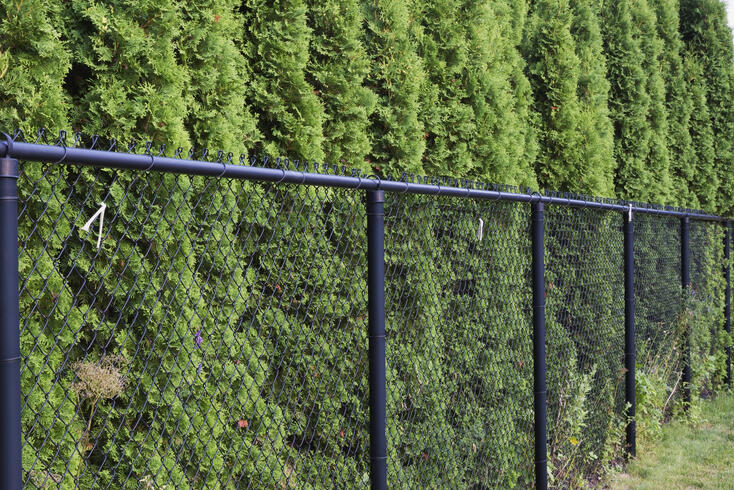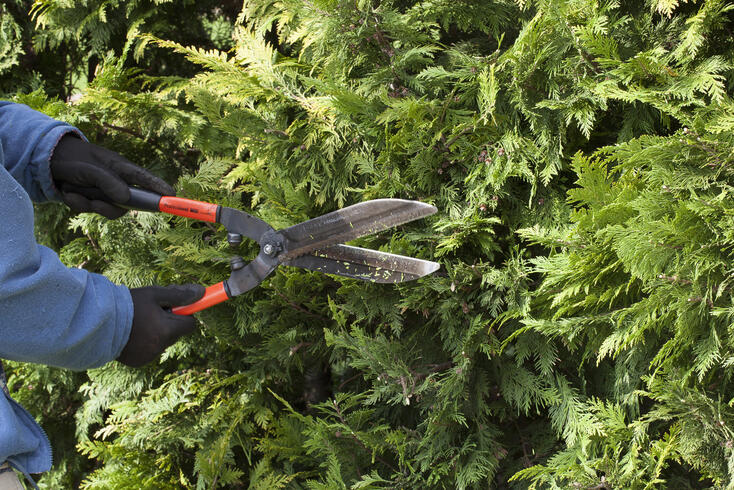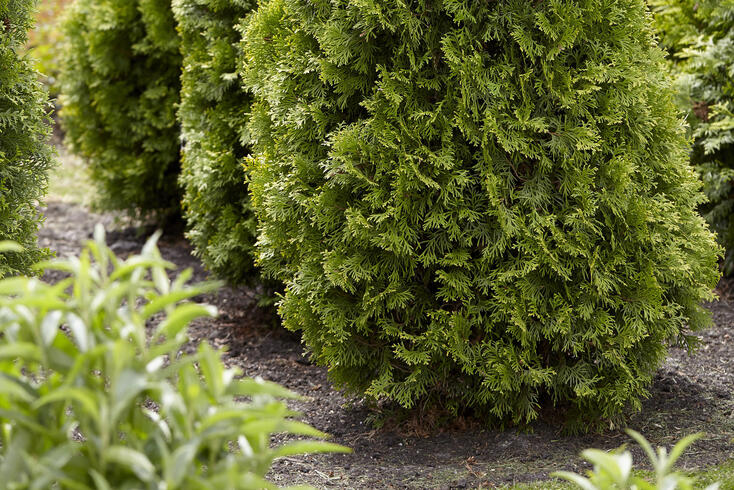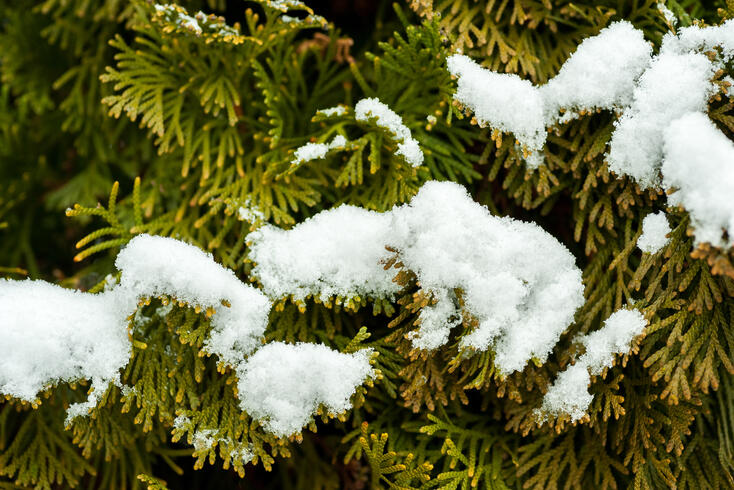Last updated on October 23rd, 2023 at 08:29 pm
Thujen have probably already passed the zenith of their popularity. In the 1970s, the robust hedge plant adorned all gardens. In the meantime, the cypress plant has fallen somewhat into oblivion – although it has a lot to offer. In addition to providing optimal privacy and wind protection, the plant grows quickly and survives even cold winters without any problems. In this article we explain what is important in the care of Thuja.
Contents
- 1 Origin and use of Thuja
- 2 Appearance and growth of the Thuja
- 3 The right location for the thuja hedge
- 4 Planting thuja: How to do it
- 5 The right care of the Thuja
- 6 How often do I have to prune my Thuja?
- 7 Is the thuja poisonous?
- 8 How often do I need to water my Thuja?
- 9 Do I need to fertilize my Thuja?
- 10 Propagation of thuja
- 11 Wintering Thuja
- 12 Popular varieties of Thuja
- 13 Diseases and pests of Thuja
- 14 Author
Origin and use of Thuja
The genus Thuja includes six species native to both North America and East Asia. In our latitudes, the frost-hardy species such as the Occidental Tree of Life (Thuja occidentalis), and the Giant Tree of Life (Thuja plicata) are particularly popular. Good to know: Species that originate in North America tend to be more frost hardy than their relatives from Asia.
Thujas, also known as arborvitae, are particularly well suited as privacy plants and thus for enclosing properties. They grow very quickly and luxuriantly, which is why more filigree varieties such as ‘Smaragd’ or ‘Holmstrup’ are particularly in demand. But the evergreen Thuja is not only suitable as a hedge plant, the tree of life also cuts a good figure as a solitary and its growth habit is reminiscent of a cypress, which would not survive a winter in our latitudes.
Appearance and growth of the Thuja
The Thuja grows as an upright conifer with either a conical or columnar habit. In its wild habitat, the tree of life grows up to 20 meters high, especially in North America, and the giant tree of life even reaches heights of up to 60 meters. The latter is mainly known under the name “Red Cedar” and is a popular wood species. Thujen also reach proud figures in terms of age: 180 years is not uncommon! In your own garden, these values can not be achieved. Here, a thuja usually grows to a height of about three meters, and the lifespan of the cultivated plant is also shorter than that of the wild species.

The right location for the thuja hedge
Plant the thuja preferably in a full sun location – but the plant can also cope with light shade. The soil is crucial for a healthy thuja hedge. It should be moist and never dry out completely, even in summer. Thuja hedges also prefer calcareous, sandy loam soils. However, the cypress plant is quite adaptable, which is why thuja can also grow on acidic sandy soils, provided that the humus content and soil moisture are right.
Planting thuja: How to do it
The optimal time for planting thuja is spring. This is because the plants then have plenty of time to root properly until winter. However, before you plant the thuja in the ground, water it abundantly. It is best to put the plant in water for a few hours.
Before planting, you should also calculate how much space the hedge plant will need. As a rule, there must be at least 40 to 90 centimeters of space in front of and behind the thuja, depending on how big and tall you want your thuja to grow. You also need to provide enough space between each plant. Depending on the thuja variety, there are different guidelines here, ranging from 30 to 50 centimeters.
The right care of the Thuja
How often do I have to prune my Thuja?
In order for the Thuja to maintain a beautiful, compact growth habit, it must be pruned regularly. If your Thuja variety is particularly vigorous, you should reach for the shears once in June and again in August. Keep the hedge narrower at the top than at the bottom, this will allow enough light to fall on the lower area.
But be careful. Do not cut off too much and never cut into the unscaled shoot areas, as the plant will have difficulty recovering from this and will hardly sprout again.

Is the thuja poisonous?
Thuja is poisonous in all parts of the plant. So it is best to wear gloves when cutting, because even skin contact can cause irritation and itching to sensitive people. If parts of the plant are accidentally consumed, mucous membrane irritations and gastrointestinal complaints are the result.
How often do I need to water my Thuja?
Thujas like to stand very moist, which is why it is especially important to water the hedge regularly during the first few years after planting. If the thuja are a little older, then they themselves also get moisture from deeper soil layers. To prevent the thuja from drying out in the summer, it is recommended to mulch the soil.
Do I need to fertilize my Thuja?
In spring, you should fertilize your thuja hedge with about two liters of compost per square meter. This will improve the soil structure and allow water to be better stored in the soil.

Propagation of thuja
Wild species of Thuja you can propagate by sowing seeds in the fall. However, note that the seeds begin to germinate only by a cold stimulus. Cultivated varieties of Thuja are best propagated by cuttings in late summer. To do this, use one- to two-year-old side shoots that are removed from the main shoot. Shorten the remaining strip of bark with a sharp knife and remove the side shoots. Then you can put the shoot in growing medium. Cover the shoots with a transparent film and ensure that the soil temperature is around 20 degrees Celsius. Good to know: Rooting takes about eight weeks.
Wintering Thuja
Thuja are usually very hardy and can survive frost without any problems, so no special care is needed in winter. Mulching the soil provides winter protection for the roots and should be done anyway for better soil structure in the summer. For younger plants, it may be necessary to water them even in November and again in time for spring, because thuja evaporates throughout the year and needs extra water. Tip: Do not use road salt near thuja hedges, this acts as an overfertilization of the plant and it is deprived of water.

Popular varieties of Thuja
Below is a list of the most popular varieties of Thuja:
- Thuja occidentalis ‘Brabant’: light green, grows about 30 centimeters per year, hardy
- Thuja occidentalis ‘Smaragd’: light green, grows about 10 to 25 centimeters per year, columnar, very frost hardy
- Thuja occidentalis ‘Malonyana’: dark green, grows about 15 to 20 centimeters per year, columnar, very frost hardy
- Thuja occidentalis ‘Teddy’: green, grows about 5 centimeters per year, spherical habit, dwarf form, soft needles
- Thuja plicata ‘Martin’: green, grows about 40 centimeters per year, very fast growing
- Thuja plicata ‘Gelderland’: dark green, grows about 40 centimeters, conical, slightly overhanging shoots
Diseases and pests of Thuja
Thuja are very low-maintenance hedge plants. However, brown shoots on the thuja are a well-known problem. Causes are on the one hand road salt, which in winter ensures that the Thuja is deprived of water. On the other hand, very acidic soils can also cause brown-black needle discoloration. However, the plant is not always actually lacking. Some varieties, such as the Occidental arborvitae, take on a uniform reddish-brown hue over the winter – so there’s no need to worry here.
There are also a number of fungal diseases that can affect thuja. The best known is Pestalotia shoot dieback, here the branches turn brown from the outer tips to the inside and die. Also characteristic of this fungal disease are round, pinhead-sized, black-brown fruiting bodies on the affected shoots. Another well-known disease is needle or scale blight.
As a rule, leaf and shoot diseases on a thuja can be controlled very well if you take timely action against them. Cut the plant back as much as possible, but not into the old wood! And treat the thuja with appropriate fungicides.
Probably the most dangerous for the thuja, however, is root rot. The fungus destroys the bark tissue of the roots. The shoots of the tree of life first turn yellow and then brown – the plant dies. The best way to fight this fungus is to immediately remove infested plants with the root ball and dispose of them in the household garbage. If they detect the infection too late, it may have already reached neighboring plants. The soil must also be replaced afterwards, as pathogens of the fungus can remain in the soil for a very long time and infect new plants.


